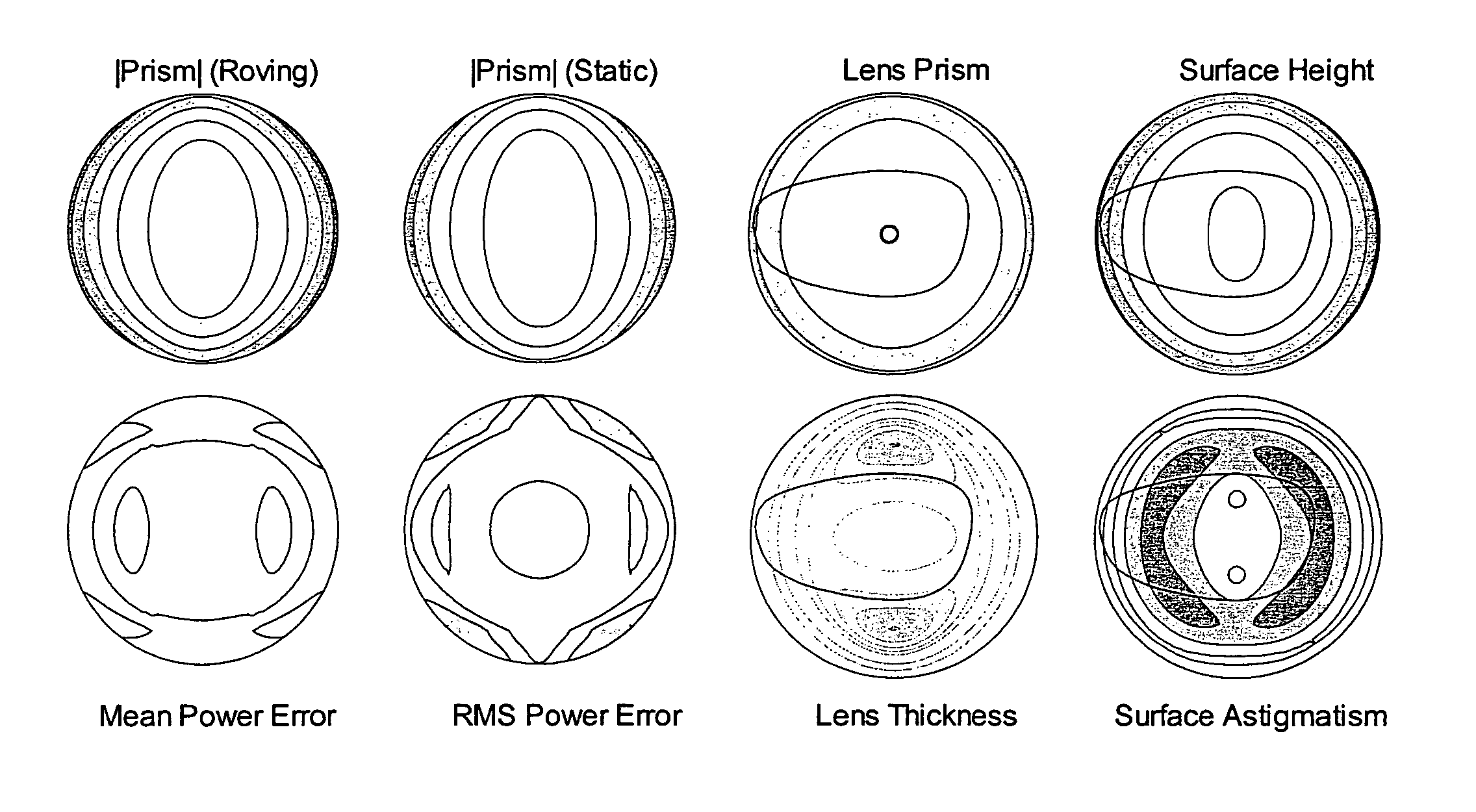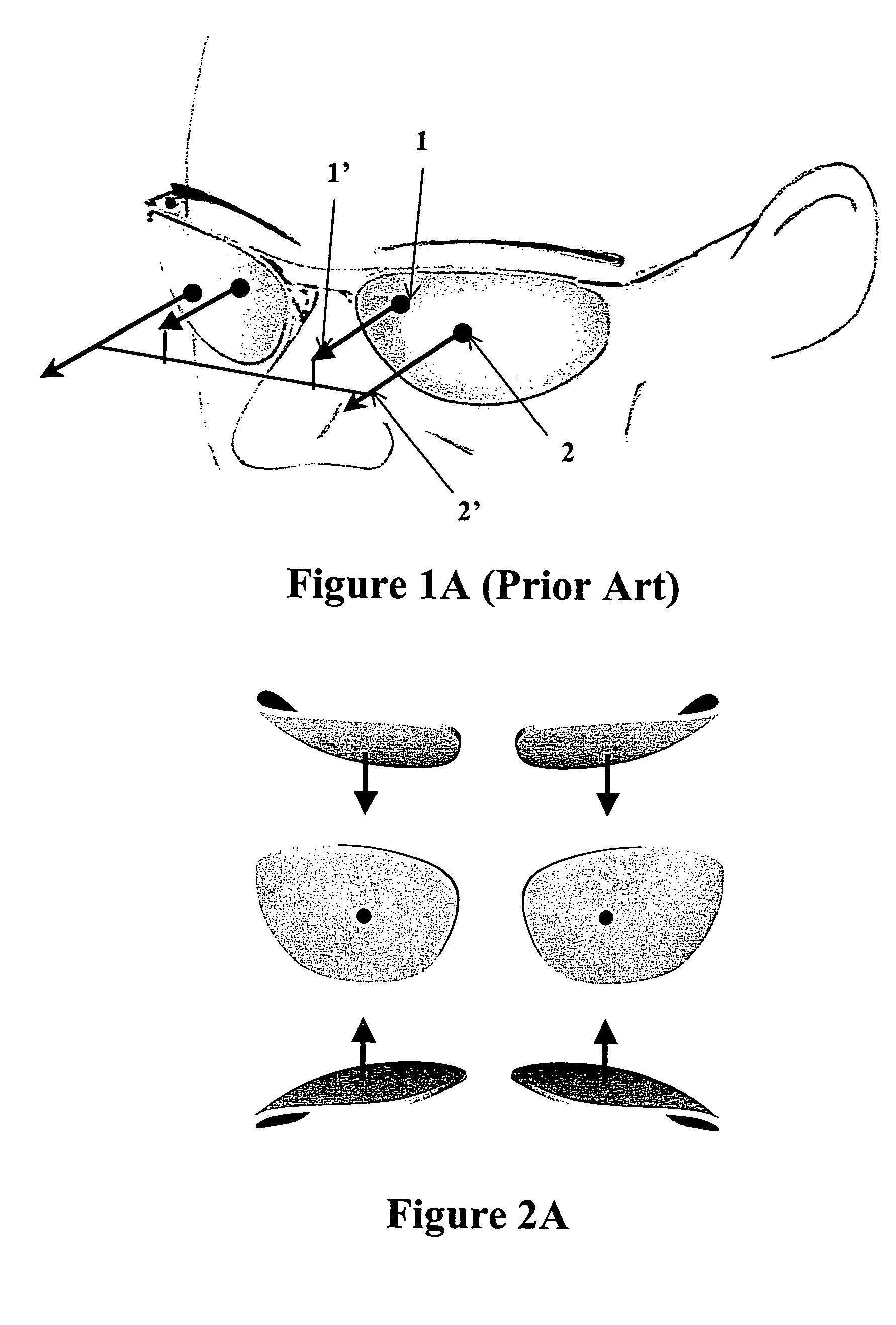Shaped non-corrective eyewear lenses and methods for providing same
a non-corrective eyewear and lens blank technology, applied in the field of optical lenses and lens blanks for non-corrective eyewear, can solve the problems of lack of global design methodology through which to create desired surface forms, and little experience in the art of single vision lens design, and achieve the effect of high levels of surface astigmatism
- Summary
- Abstract
- Description
- Claims
- Application Information
AI Technical Summary
Benefits of technology
Problems solved by technology
Method used
Image
Examples
example 1
(Prior Art)
Non-Corrective Elliptical Lens
[0199]Tackles describes in U.S. Pat. No. 5,774,201, non-corrective lens forms suitable for unitary or dual lens eyewear having substantially elliptical cross-sections in a horizontal plane and a variety of forms vertically. The preferred horizontal arcs are ellipses with eccentricity in the range 0.10 to 0.85 and they extend between one apex of the major axis and the opposed apex, around the minor axis vertex. Accordingly, (1) the medial portion of the horizontal arc of the lenses has lower curvature than the remainder of the arc (2) the lateral ends have gradually tightening curvature relative to the medial portion, and (3) the curvature change from medial to lateral regions horizontally is smooth, being a stated advantage of the configuration.
[0200]Tackles allows specifically that the length of the major axis of the ellipse may vary along the length of the arcuate section, provided that the cross-section conforms substantially to an ellipse...
example 2
(Prior Art)
Aspheric Sunglass
[0203]In U.S. Pat. No. 5,604,547, Davis and Waido describe non-corrective sunglass or eye protector polycarbonate lenses of the unitary wrap around style comprising a pair of surfaces forming lenses of “substantially uniform” thickness throughout, each surface being a figure of revolution generated by conic sections. The axis of rotation is the optical axis of the lens. It is placed mid-way between the wearer's direct lines of sight as worn, corresponding to the Cyclopean axis within the wearer's medial plane. Davis and Waido disclose in particular (Claim 18) a method of bending the peripheral limit of a unitary shield beyond the wearer's forward field of binocular vision (that is, at visual field angles beyond 40 o or 50 o from the wearer's direct line of sight), by combining front and back surfaces having central regions of curvature between 1.0 and 6.0D with other polynomial terms having exponents between 10 and 30, according to the sag equation
z=Ar2+B...
example 3
“Non-Quadratic” Polynomials
[0211]A basis of embodiments of the present invention is the ability to achieve desirable and controllable surface shapes by the use of generating curves that are substantial mathematical distortions of a circle, ellipse, or any standard quadratic curve. Applying a distorting function to a standard quadratic curve may create a desired curve. Alternatively, the curve may be defined directly by a functional or polynomial expression. Direct formulation of the surface generating curve(s) is frequently desirable. One such approach is given below.
[0212]A suitable rotationally symmetric oblate surface will satisfy the relationship
[0213]z(r)=∑n≥2mAnrnwherez″(rz′)3_(12A2)2.
[0214]The condition stipulates that the form of the polynomial will be dominated by coefficients An where n≧3 and these will change in a sequence unlike that for a conicoid.
[0215]We may apply various boundary conditions at the vertex r=0 and a lateral position r=ρ, in order to pre-disp...
PUM
 Login to View More
Login to View More Abstract
Description
Claims
Application Information
 Login to View More
Login to View More - R&D
- Intellectual Property
- Life Sciences
- Materials
- Tech Scout
- Unparalleled Data Quality
- Higher Quality Content
- 60% Fewer Hallucinations
Browse by: Latest US Patents, China's latest patents, Technical Efficacy Thesaurus, Application Domain, Technology Topic, Popular Technical Reports.
© 2025 PatSnap. All rights reserved.Legal|Privacy policy|Modern Slavery Act Transparency Statement|Sitemap|About US| Contact US: help@patsnap.com



